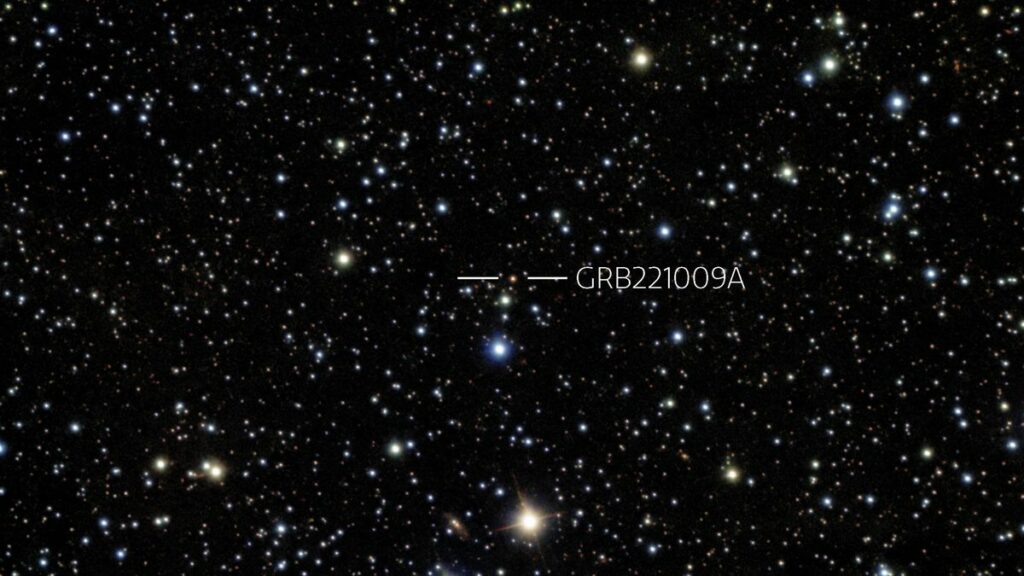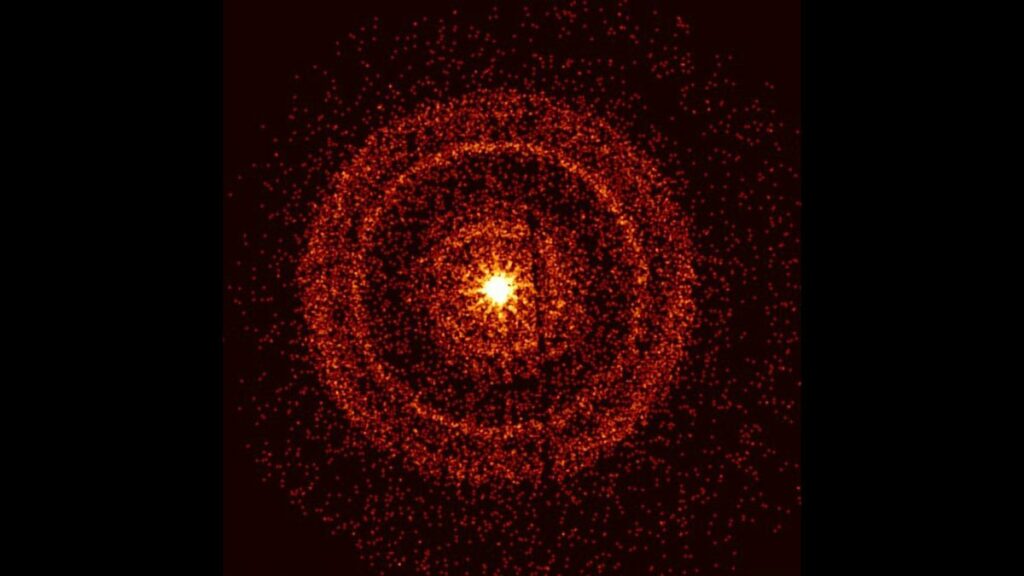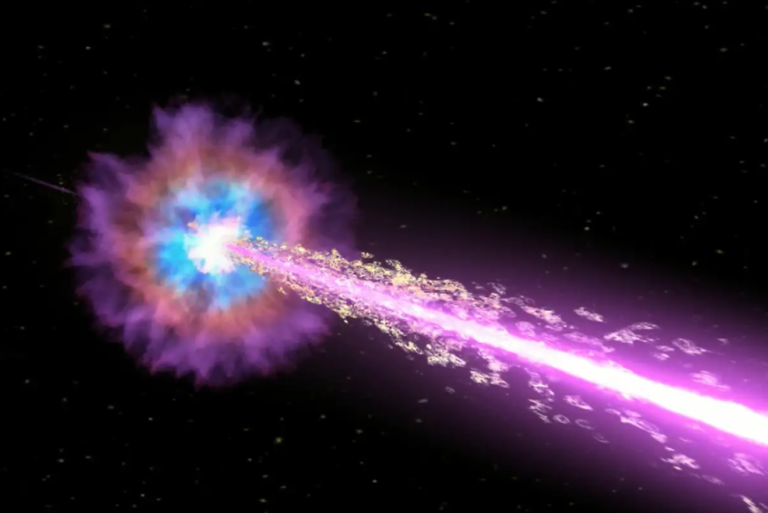Unprecedented ‘BOAT’ Gamma-Ray Burst Disrupts Earth’s Atmosphere
Named BOAT for being the Brightest Of All Time, this gamma-ray burst is also the inaugural event of its kind to impact Earth’s upper ionosphere.
In October of last year, scientists observed a celestial anomaly that stirred curiosity. Emanating from the cosmic void between stars, an abundance of deep-space X-rays inundated observatories, seemingly linked to an extraordinarily intense event within our galaxy—a gamma-ray burst (GRB). These bursts, associated with phenomena like stellar explosions and the birth of black holes, are typically energetic, but the one witnessed last year, nicknamed BOAT (Brightest Of All Time), surpassed conventional GRBs in luminosity, akin to a floodlight overshadowing a lightbulb.
Initially believed to be the brightest GRB since the dawn of human civilization, BOAT exhibited photons carrying more energy than those produced by the Large Hadron Collider. What made BOAT even more extraordinary was the revelation that it didn’t originate from the Milky Way but hailed from a galaxy beyond our own, underscoring the unparalleled brilliance of this cosmic event.
On November 14, researchers released a paper addressing a question that likely intrigued many: What are the implications of this super-bright GRB for us? According to the study, the seven-minute burst, still detectable for 10 hours afterward, induced significant “variations” in Earth’s atmosphere. Most notably, these variations appeared to manifest in the upper ionosphere—the frontier between our planet and outer space. If validated, this observation marks the first instance of a GRB impacting this region, making it a unique event in the history of gamma-ray burst measurements.
The importance of these findings lies in the fact that life on Earth hinges on the stability of our atmosphere. Mirko Piersanti, the lead author of the study from the University of L’Aquila in Italy, emphasized the significance, stating, “There has been a great debate about the possible consequences of a gamma-ray burst in our own galaxy.”
What do you mean by ‘variations?’
Earth’s atmosphere is comprised of distinct layers, with the ionosphere situated in the uppermost region, spanning from approximately 31 miles (50 kilometers) to 590 miles (950 km) in altitude. The segment above 217 miles (350 km) is considered the upper half, and crucially, the ionosphere is populated with charged particles, or ions. The recent study’s authors observed disruptions in this upper half, specifically around 310 miles (500 km) in altitude.
These disturbances, variations, or perturbations discussed in the study essentially denote alterations in the electric field of the upper atmosphere, directly impacting the charged particles within the ionosphere. Typically, disturbances in the ionosphere are associated with energetic particle events originating from our sun. However, in the case of BOAT, scientists believe its interference resulted from the explosion of a star situated almost two billion light-years away. This aspect contributes to the astonishment surrounding the event, as it directly affected Earth’s outer shell.
“We can observe events in deep space that also have repercussions on Earth,” remarked Erik Kuulkers, European Space Agency (ESA) Project Scientist. Statistically, a gamma-ray burst (GRB) as luminous as this is expected to occur only once every 10,000 years, according to ESA officials.
Upon reaching Earth, this exceptional GRB triggered lightning detectors in India, activated instruments in Germany, dispersed evidence of its photon flux over Asia and parts of Australia, and even left behind a lingering afterglow.

In the recent study, scientists scrutinized the BOAT using data gathered from the China Seismo-Electromagnetic Satellite spacecraft (CSES), positioned in low Earth orbit. This satellite, typically dedicated to studying the ionospheric effects of earthquakes, played a crucial role in uncovering the results presented today. While other tools, including the ESA’s Integral satellite, were employed to model their ultimate conclusions, the primary data source was the CSES.
“We had sought this effect from other GRBs in the past but had observed nothing,” noted Ubertini. The authors emphasized in their new paper that, to the best of their knowledge, this GRB ranks among the largest ever detected.
Importantly, BOAT also influenced some of the lower layers of the ionosphere. Laura Hayes, an ESA solar physicist and co-author of a 2022 study on the consequences of lower ionosphere disturbances, clarified, “Notably, this disturbance impacted the very lowest layers of Earth’s ionosphere, situated just tens of kilometers above our planet’s surface, leaving an imprint comparable to that of a major solar flare.”

It’s fine, we’re fine
While the European Space Agency (ESA) suggests that “analyzing the effects of the blast could provide information about mass extinctions in Earth’s history,” the team’s paper does not explicitly propose that an eruption like BOAT could lead to the end of humanity. Instead, this eruption might offer valuable insights into the potential consequences if a genuinely threatening gamma-ray burst (GRB) were to impact our planet.
In their recent paper, the team notes that “being able to abruptly increase atmospheric ionization, they might deplete stratospheric ozone on a global scale.” The ozone layer serves as Earth’s sunscreen, safeguarding inhabitants from harmful ultraviolet rays emitted by the sun. Overexposure to these rays can increase the risk of cancer and cataracts in humans and lead to the death of many plants exposed to excessive UV radiation.
While there is currently no cause for immediate concern about our ozone layer (even the ozone hole is healing), scientists are intrigued by the potential impact of a future GRB on Earth. This investigation aligns with the specific goals of the team behind the new study.
Simultaneously, other astronomers are delving into the cause of BOAT. Despite efforts by the James Webb Space Telescope and Hubble Space Telescope teams, the search has yielded no conclusive results. Both telescopes were unable to pinpoint the aftermath of a star explosion in the region of the cosmos where BOAT occurred.
Furthermore, the original BOAT X-ray signals offer ample material for study. These wavelengths traversed vast distances in space, passing through dust clouds and encountering various cosmic phenomena, collecting valuable information that awaits decoding by human researchers.
The study was published on Nov. 14 in the journal Nature Communications.
This article is republished from SpaceCom under a Creative Commons license. Read the original article.
Do not forget to share your opinion with us to provide you with the best posts !




0 Comments